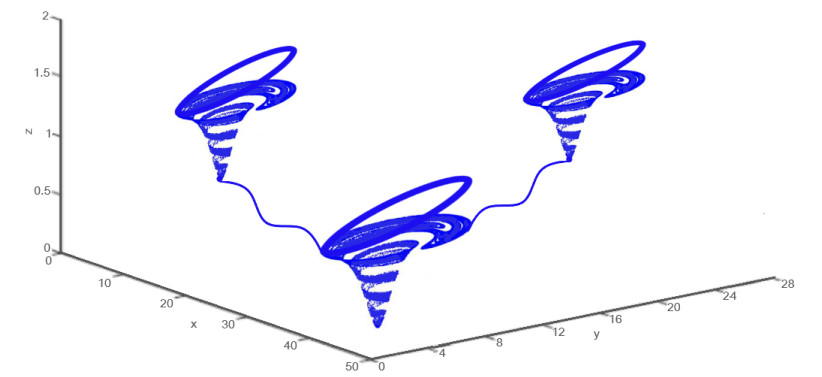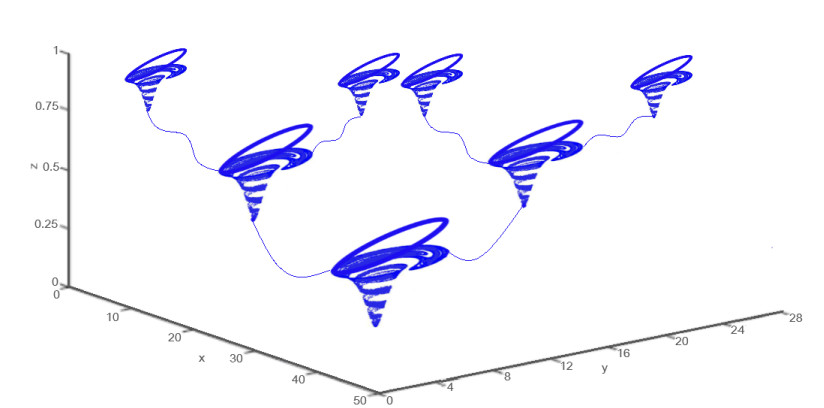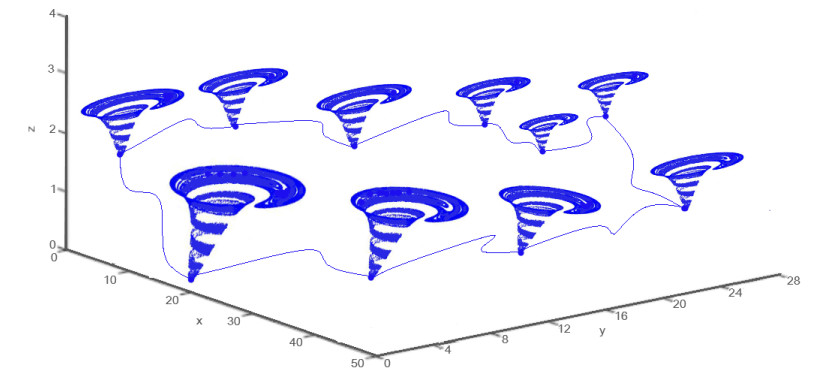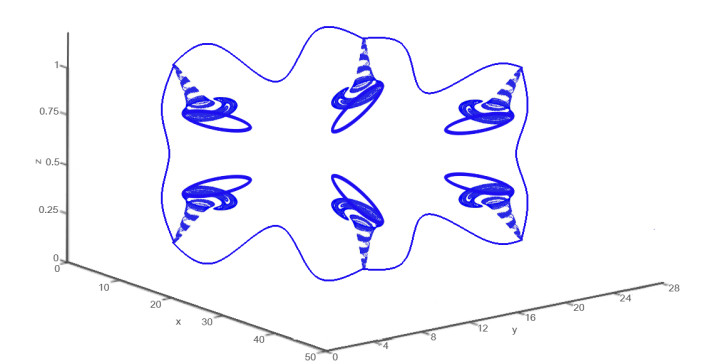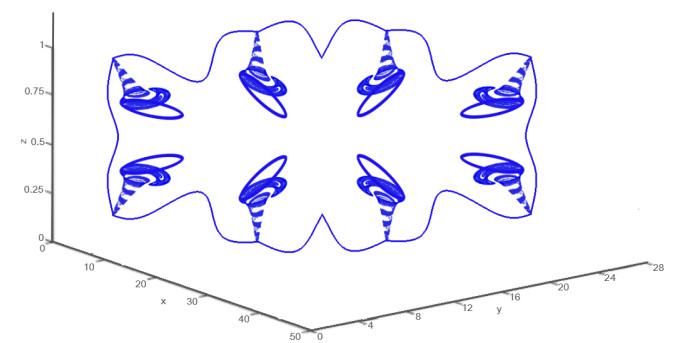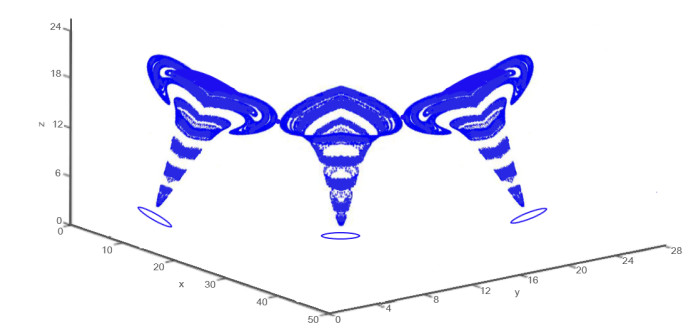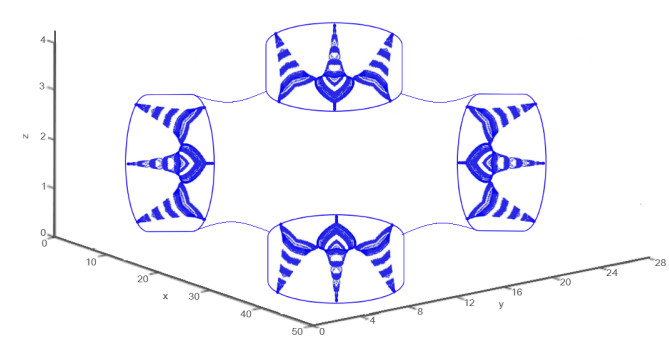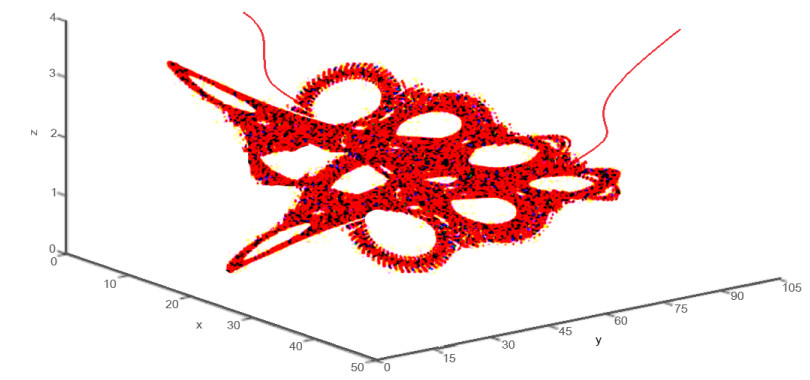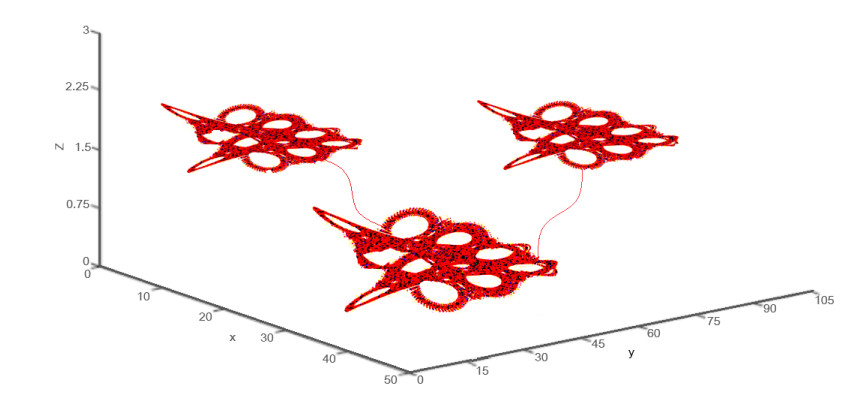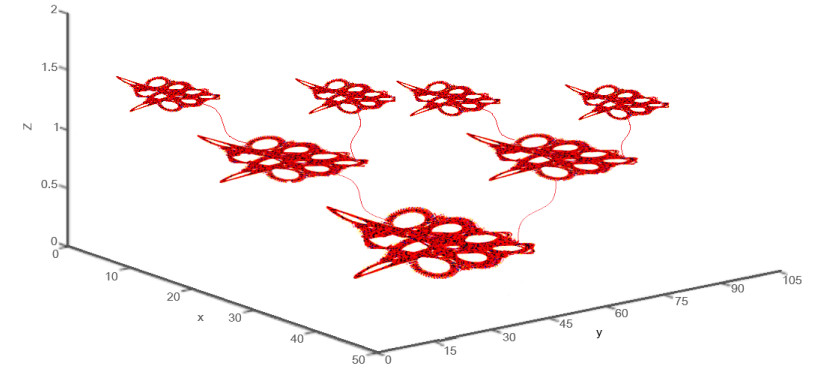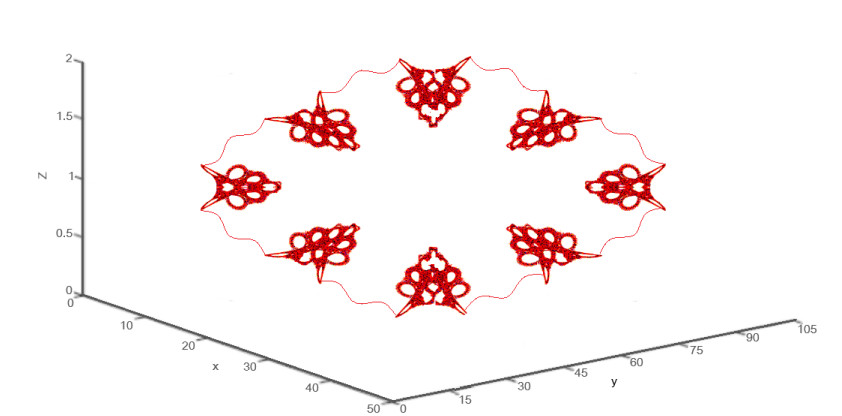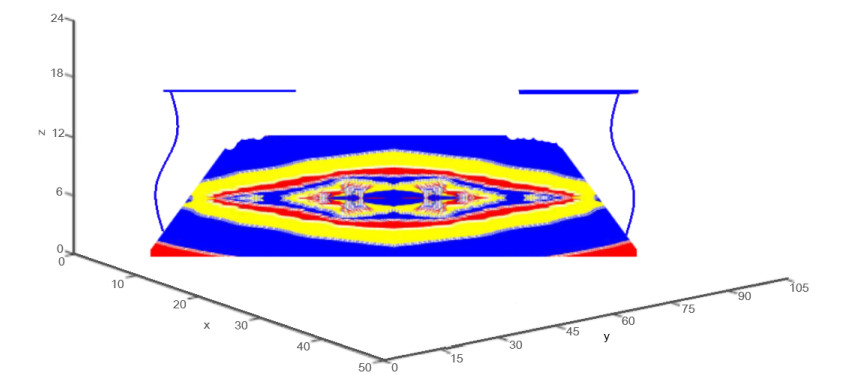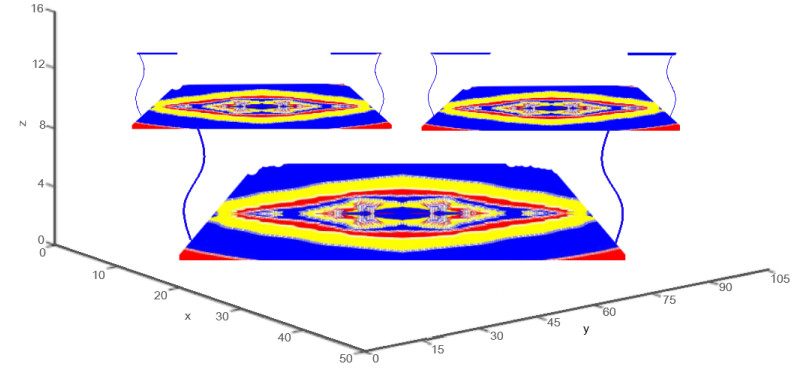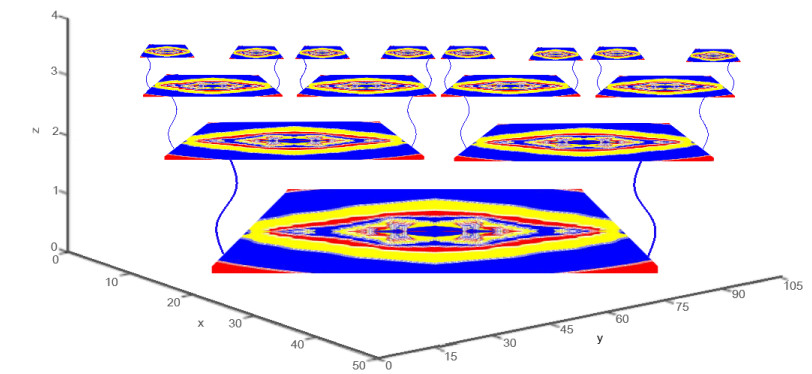1.
Introduction
The world within which humans leave is very complex and can exhibit many different behavior. Some of these behaviors are very difficult to be analyzed via observation only. However, some can be replicate using mathematical formulas. Mathematicians have classified some real world behaviors as they were able to replicate those using mathematical formulas. In the literature, one will find, concepts like fractal, chaos, random walk, Levy flight motions [1], Brownian motions [2], Bernoulli process, Markovian process [3], non-Markovian process [4] and many other that will not be listed here. The concept of fractal have attracted attention of researchers from all background due to their appearance in real world [5,6,7,8,9]. It is even believed that, this concept was already developed in Africas cultures as many of their constructions resembled self-similarities, for example, the structure of their traditional kingdom resembled the structure of the villages. It has also mentioned that, their traditional clothes could be seeing as fractal designs. The concept has been developed in mathematics, for example some mathematical mapping have been used to replicate these fractal behaviors observed in real world problems. Some of the well-known mapping are the Julia, Mandelbrot, Fatou and Newton mappings. These mapping have been intensively studies as they are able to produce many different type of theoretical fractal behaviors. In particular these mapping are derived using polynomials with two dimensional complex numbers. The concept was extended in system call quaternion which is a 4 dimensional complex numbers. However, Atangana and Toufik argued that the nature within which humans leave is neither two dimensional nor 4 dimensional therefore fractal represented by these two sets may not be very representative in humans world therefore they suggested a set 3-dimensional complex numbers and called it Trinition [10]. The Trinition polynomial are able to reproduce fractal in 3-dimension which can be found in many real world problems. Above this concept of mapping, mathematicians have suggested other operators called fractal differentiation and integration, these mathematical operators are able to depict some degree of self-similarities. Recall that many authors have applied the concept of fractal-fractional operator in number of mathematical circumstances and proposed many related applications in connection to real life phenomena. Some of them are found in [11,12,13,14]. Some researchers have applied the concept of fractal-fractional in various processes related to real life phenomena, such as mathematical epidemiology, control theory, Levy statistics continuous time random walk, biomedical engineering, fractional signal and image processing, fractional filters motion and nonlocal phenomena [8,11,15,16,17,18]. We can also mention the concept of self-similarity found in the nature around us which takes into account the fractal dimension applicable in the domain of engineering and including aspects like fatigue loading conditions and fracture surface analysis [19]. The authors in [20] pointed out the fractal impact on microstructure and its relationship to properties such as fracture toughness or fracture energy. The variety of these works and publications show the vast range and scope that cover the application of fractional processes combined with fractal dynamics in various domains of sciences. In this paper, we shall analyze some real world problems using fractal-fractional differential operators.
2.
Preliminaries on fractal-fractional derivatives
The concept of fractal-fractional derivative was developed and introduced recently with the aim of attracting and describing a considerable amount of non-local problems found in nature and also respecting the fractal structure that characterize them [11,13,15]. It is defined to be the convolution of fractal differential operator with the usual functions (power, exponential and Mittag-Leffler laws) of fractional calculus. The literature comprises various definitions of the fractal-fractional derivative depending on the type of law used. Some are given as follow:
Definition 2.1. We consider X∈R3, a,b∈R, and assume that h(t,x) defined on (a,b)×X is t−fractal differentiable with the order γ on the interval (a,b) then, the fractal-fractional derivative of h of order γ in the sense of Riemann-Liouville with power law reads as:
where ∂∂tγh is defined as
The generalized version of (2.1) is defined by
with ς>0 and ∂ς∂tγh given by
Similarly, the Caputo version od that definition can be given:
Definition 2.2. We consider X∈R3, a,b∈R, and assume that h(t,x) defined on (a,b)×X is t−fractal differentiable with the order γ on the interval (a,b) then, the fractal-fractional derivative of h of order γ in the sense of Caputo with power law reads as:
with the generalized version
The following definitions are related to exponential law:
Definition 2.3. We consider X∈R3, a,b∈R, and assume that h(t,x) defined on (a,b)×X is t−fractal differentiable with the order γ on the interval (a,b) then, the fractal-fractional derivative of h of order γ in the sense of Riemann-Liouville with exponential law reads as:
where q(0)=q(1)=1 with the generalized version
Definition 2.4. We consider X∈R3, a,b∈R, and assume that h(t,x) defined on (a,b)×X is t−fractal differentiable with the order γ on the interval (a,b) then, the fractal-fractional derivative of h of order γ in the sense of Caputo with exponential law reads as:
with the generalized version
The following definitions are related to Mittag-Leffler law:
Definition 2.5. We consider X∈R3, a,b∈R, and assume that h(t,x) defined on (a,b)×X is t−fractal differentiable with the order γ on the interval (a,b) then, the fractal-fractional derivative of h of order γ in the sense of Riemann-Liouville with Mittag-Leffler law reads as:
where w(γ) is a regularization function. Here the generalized version
Definition 2.6. We consider X∈R3, a,b∈R, and assume that h(t,x) defined on (a,b)×X is t−fractal differentiable with the order γ on the interval (a,b) then, the fractal-fractional derivative of h of order γ in the sense of Caputo with Mittag-Leffler law reads as:
where w(γ) is a regularization real function related to the definition and with a more general version given as
3.
Numerical solution with the definition in Caputo sense with exponential law
We use the Definition 2.2 formulated in the previous section and express the numerical solution for the fractal-fractional differential equations using the predictor-correction method. This scheme was suggested very recently to help recover some missing terms the scheme suggested by Atangana and Seda [21]. Hence, we consider a general non-linear equation with fractal-fractional differential operator given as
To proceed we convert the equation into Volterra version as
For simplicity, we set τ1−βf(τ,Y(τ))=F(τ,Y(τ)). Following the result by [22], we have
where the predictor is given as
Finally
4.
Numerical solution with the definition in Atangana-Baleanu sense with Mittag-Leffler law
Using the Definition 2.5, we consider a general non-linear equation with fractal-fractional differential operator given as
Following the same approach, we convert the equation into Volterra version as
Taking again τ1−βf(τ,Y(τ))=F(τ,Y(τ)), we obtain
where the predictor is given as
Finally
5.
Application to some real life phenomena
We use the schemes proposed in the previous section to solve some nature related models and access their behavior when they are under the influence of the fractal fractional operator.
5.1. Application 1: The three-dimentional fractal in tornado system
On the system, we analyze and assess here, the impact of the fractal-fractional derivative in Riemann-Liouville sense with exponential law given in Definition 2.3. To that effect, we combine it with the three-dimensional tornado system proposed in [10,(42)] to get:
and
In order to conveniently solve the combined fractional and fractal system, it is important to associate it with the following initial conditions:
Numerical simulations of model (5.1) and (5.3) are shown in Figure 1 to Figure 6 which show the three-dimensional fractal structures to be in a self-replication process with the influence of the fractional derivative that extends the self-replication in number and shape as the derivative order varies. Similar behavior is produced and observed for the model (5.2) and (5.3) as shown in Figure 7 and Figure 8.
5.2. Application 2: The three-dimentional fractal in Dubai superposed roads mapping system
we perform another application by combining the Definition 2.5 to the three-dimensional superposed roads mapping system proposed in [10,(45)] to get
with the following initial conditions:
Numerical simulations of model (5.4) and (5.5) are shown in Figure 9 to Figure 12 which, again, show the three-dimensional fractal structures of the superposed roads mapping system to be in a self-replication process with the influence of the fractional derivative that extends the self-replication in number and shape as the derivative order varies.
5.3. Application 3: The three-dimentional fractal in trinition system
lastly, we combine the Definition 2.3 to the trinition system defined in [10,(26)] to obtain
with the following initial conditions:
Numerical simulations of model (5.6) and (5.7) are shown in Figure 13 to Figure 16 which, again, show the three-dimensional fractal structures of the trinition system to be in a self-replication process with the influence of the fractional derivative that extends the self-replication in number and shape as the derivative order varies.
6.
Concluding remarks
Existence of mathematically produced three-dimensional fractal structures with fractional impact has been shown in this paper. Indeed, we have used the fractal operator combined to the fractional operator with both exponential and Mittag-leffler laws to analyze and solve generalized three-dimensional systems related to real life phenomena. Related numerical solutions have been provided in each case and applications to some related systems have been performed. The three-dimensional fractal structures is proven to be in a self-replication process with the influence of the fractional derivative that extends the self-replication in number and shape as the derivative order γ varies. This paper improves the preceding ones as it opens doors for further investigations that shall lead to the analysis and development of higher dimensional fractal structures produced by mathematical models.
Conflict of interest
The authors declare that there is no conflict of interest related to this paper.
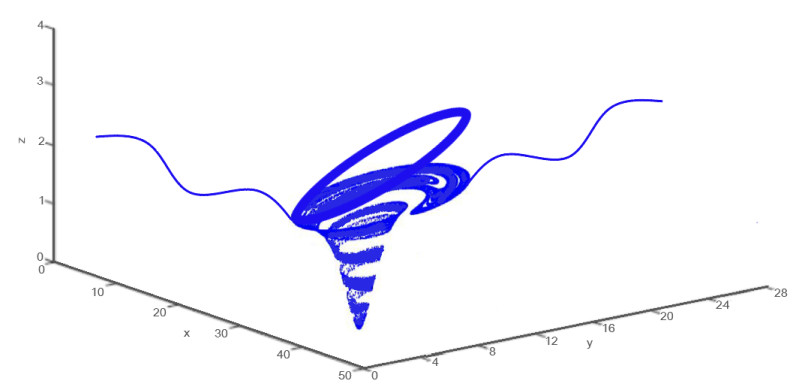









 DownLoad:
DownLoad:
